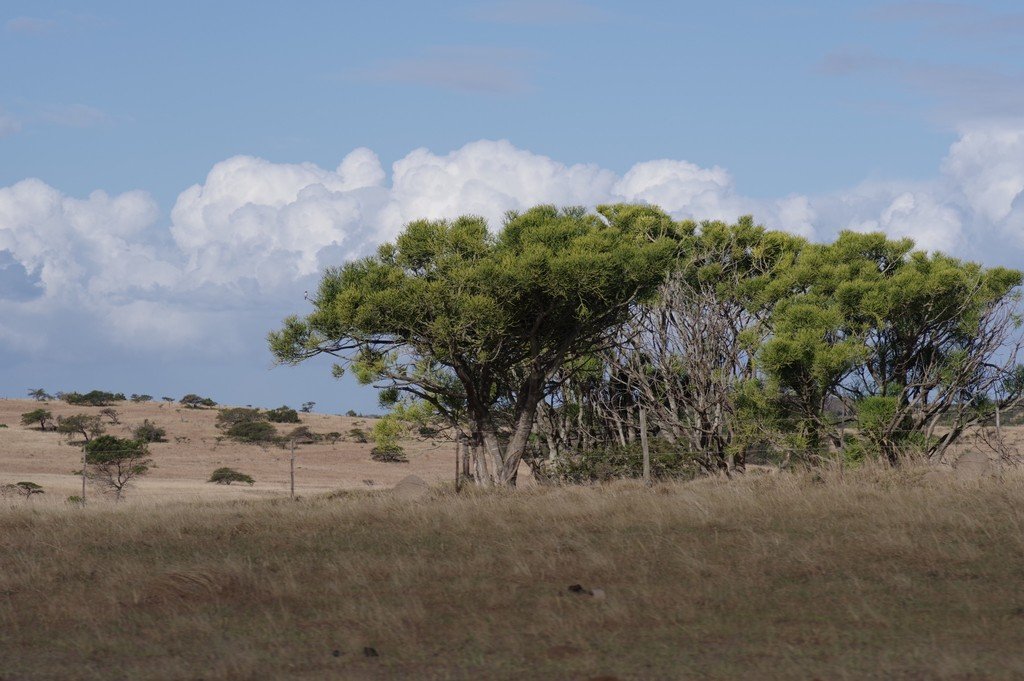Fire Sticks
Euphorbia tirucalli
This species is sometimes called “pencil cactus” though this is not a cactus at all, but a succulent shrub or tree. In frost free areas it can reach 25’ tall and develop a woody trunk. In our region, the cold is what limits its size, and this species is often grown in containers. The stems are succulent with white latex in the stems. In cool weather, or intense sun exposure or drought, the tips on many plants turn reddish. Some cultivars are entirely red (these are much slower-growing plants, since they lack the amount of chlorophyll that would help them grow faster). Tiny leaves occur that are under an inch long. The yellow flowers are at the ends of the branches and are tiny. Flowers are followed by small capsules divided into three sections where the seeds are contained.
Grow in full sun to shady conditions. This plant can sometimes grow indoors but doesn’t have good form when grown in sun-deprived locations. This is a summer grower and as long as the plants have good drainage, can be watered extra to encourage growth. They are drought tolerant, however—we recommend plants be watered 2-3 times a month in summer, maybe lightly once a month or less in winter, especially if there is no rain. Don’t let plants stay wet for too long in the winter. Protect from frost. Plants will be damaged under 30°F, but can grow back after frost damage. Best to cover or otherwise protect plants from frost in the winter.
The yellowish flowers attract butterflies, bees and other insects. These are primarily responsible for pollination as the flowers also produces minute quantities of nectar.
Its latex can also be used as fuel. This led chemist Melvin Calvin to propose the exploitation of E. tirucalli for producing oil. This usage is particularly appealing because of the ability of E. tirucalli to grow on land that is not suitable for most other crops. Calvin estimated that 10 to 50 barrels of oil per acre was achievable. In the 1980s the Brazilian national petroleum company Petrobras began experiments based on these ideas. It has also been used in the production of rubber.
Euphorbia tirucalli is used as alternative medicine in many cultures. Attempts have been made to use it to treat cancer, excrescence, tumors, warts, asthma, cough, earache, neuralgia, rheumatism, and toothaches in countries including Brazil, India, Indonesia, and Malaysia. More research should be done on this species to determine how best to use it, since sometimes the side effects are undesirable. Care should always be taken when using any Euphorbia species internally or externally. Some people complain of contact dermititus when trimming plants, while other people are completely unaffected. Take care not to get latex in your eyes if you are pruning the plant.
The genus name, Euphorbia, derives from Euphorbos, the Greek physician of King Juba II of Numidia and Mauretania (52–50 BC – 23 AD). Juba was a prolific writer on various subjects, including natural history. Euphorbos wrote that one of the cactus-like euphorbias (now called Euphorbia obtusifolia ssp. regis-jubae) was used as a powerful laxative. The specific epithet, tirucallii comes from the Indian-Malayalam names of tiru meaning good and kalli meaning medicinal plant qualities. There are 2105 species of Euphorbia worldwide, making it one of the most diverse plant genera in the world.
This species has a wide distribution in Africa in black clay soils, being prominently present in northeastern, central and southern Africa. It may also be native in other parts of the continent as well as some surrounding islands and the Arabian Peninsula. It grows in dry areas, especially the savanna, and is often used to feed cattle or as hedging.
These plants are often grown in containers. Photo by Daderot, Wikipedia
These plants are showing the coloration on the tips of the stems. Photo by mark6mauno, Flickr

This flower is being pollinated by a small wasp in South Africa. Photo by Alan Manson, iNaturalist

In their native habitat these plants become quite large and sometimes form small groves. Photo of some fire stick trees in South Africa. Photo by Craig Peter, iNaturalist



